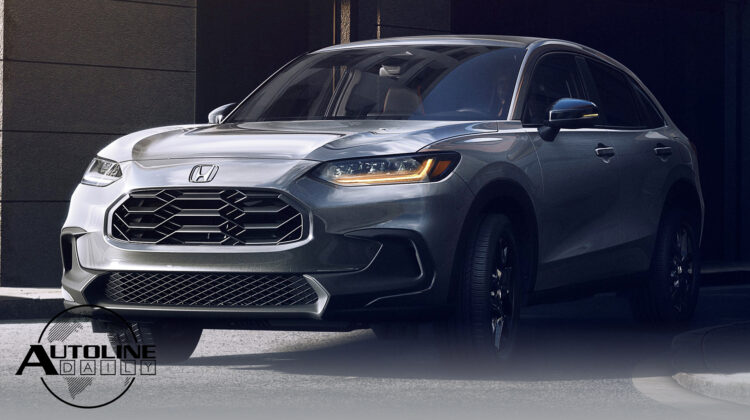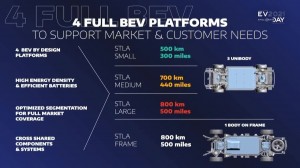
Listen to “AD #3296 – GM and Honda Focus on Affordable EVs; All-New Honda HR-V Gets Bigger; Ranking EV Sales in March” on Spreaker.
Follow us on social media:
Runtime: 9:13
0:07 GM & Honda Expand EV Partnership
0:55 Nissan Delays the Ariya Again
1:20 GM Finally Restarts Bolt Production
1:59 China Worried About Surging Lithium Prices
3:03 Electric Charger & Challenger Production Revealed
3:50 All-New Honda HR-V Bigger Than Ever
4:27 Stellantis Tests 5G to Improve Safety
5:04 How V2X Can Improve AVs
6:18 BMW Invests in Natural Fiber Composites
7:04 Stacking Up the Chinese EV Startups
7:46 Ranking Non-Telsa U.S. EV Sales
Visit our sponsors to thank them for their support of Autoline Daily: Bridgestone, Intrepid Control Systems and Schaeffler.
This is Autoline Daily, the show dedicated to enthusiasts of the global automotive industry.
GM & HONDA EXPAND THEIR EV PARTNERSHIP
General Motors and Honda are expanding their EV partnership. They will co-develop a series of mass market electric vehicles based on a new global architecture that will use GM’s Ultium batteries. While they didn’t provide specific numbers, GM and Honda plan to produce millions of the new EVs starting in 2027, which will include compact crossovers. The companies will also work toward standardizing equipment and they’ll explore collaborations on advanced battery technology in the future. This new partnership expands on their previous agreement. Honda is developing two vehicles based on GM’s Ultium platform. The Prologue, which debuts in early 2024 and an Acura SUV that will follow after that.
NISSAN DELAYS THE ARIYA AGAIN
And in other EV news, Nissan is once again delaying the launch of the Ariya due to the chip shortage and other supply issues. The model was originally supposed to go on sale in the middle of last year. Nissan then targeted the end of March but now says it will go on sale in May in Japan. It then heads to Europe this summer followed by the U.S. in the fall.
GM FINALLY RESTARTS BOLT PRODUCTION
General Motors has finally resumed production of the Bolt EV and EUV. GM stopped building the models last August after it had to recall more than 140,000 of them due to battery fire risks. GM prioritized replacing batteries in recalled models but it now has enough new battery modules to resume production. Manufacturing defects in the batteries, which were made by LG Energy Solutions, caused 18 Bolts to catch fire globally. LG agreed to pay $1.9 billion of the $2 billion the recall was estimated to cost.
CHINA WORRIED ABOUT SURGING LITHIUM PRICES
First it was nickel, now it’s lithium. Last week, we reported that nickel demand is soaring for EVs. Now, China is growing concerned over the surging price of lithium, which is also an essential ingredient for EV batteries. It held talks with lithium suppliers and industry groups last month in an effort to address the price surge. The price has shot up 472% since last June to a record high in March in China. Globally, the price of lithium has jumped 490% in the past year. And it could keep going up. According to Bloomberg, lithium demand will increase five-fold by the end of the decade.
ELECTRIC CHARGER & CHALLENGER PRODUCTION REVEALED
Stellantis kind of shocked muscle car enthusiasts when it announced the next generation of Dodge Charger and Challenger will be all electric. And now we know when they’re going into production. Autoforecast Solutions reports they’ll start running down the assembly line in August, 2024 at the Belvidere assembly plant in Illinois. The IC versions of those cars are currently made at the Brampton plant in Canada. The electric versions will be made on the STLA (stella) Large Platform, and Stellantis says it will deliver sub two-second 0 to 60 times, an efficiency of 4.3 miles per kilowatt hour, and 800 kilometers of range, which is nearly 500 miles.
ALL-NEW HONDA HR-V GETS BIGGER
Speaking of new models, here’s the all-new Honda HR-V for North America. It went with a completely different look for its second generation. Gone are the expressive character lines down the side and the grille is a whole new look for Honda. Not only that, but it’s based on the new Civic, so the HR-V is now longer and wider than the outgoing model. While Honda hasn’t said what will power the small crossover, we’d expect something similar to what you can find in the Civic. The all-new HR-V is scheduled to launch this summer, so we should learn more soon.
STELLANTIS TESTS 5G TO IMPROVE SAFETY
There’s still too many vehicle-related deaths every year. One way automakers are looking to improve safety is with connected vehicle technology. Stellantis was just part of a test in Virginia that used a Jeep Wrangler 4xe equipped with 5G V2X or vehicle-to-everything technology and intersections with fixed cameras and sensors, so safety alerts can be sent right to drivers and pedestrians. That way they can take action or be on alert sooner. The technology also lets drivers and pedestrians get emergency notifications.
HOW V2X CAN IMPROVE AVs
And a video released by German supplier ZF shows how those notifications can improve autonomous driving. If emergency crews are working or there’s a vehicle broken down at the side of the road an alert can be sent to the vehicle with V2X technology. Once it receives the signal it will automatically slow down to a safe speed. If that’s not enough, the self-driving vehicle will change lanes, too, to avoid the issue and then get back over when it’s safe again. It just goes to show that connected car tech is for more than just over-the-air updates.
BMW INVESTS IN NATURAL FIBER COMPOSITES
All automakers are working to become more carbon neutral and for BMW that means investing in a company, called Bcomp, that makes composites with natural fibers. One of the solutions it’s developed is a 3D structure that kind of looks like fencing with a thin layer of fiber laid over. It’s said to cut plastic use in interior components by up to 70% and lower CO2 emissions by as much as 60%. Bcomp also makes a number of composite components with natural fibers that can cut weight up to 50% compared to conventional materials. While BMW has featured these components on its race cars they’re now working on developing parts for production cars.
STACKING UP THE CHINESE EV STARTUPS
China has all kinds of EV startups that want to be the next Tesla. But only 5 of them are emerging as serious players and here’s how their latest sales stack up against each other. Xpeng is leading the pack. It sold over 15,000 EVs last month in China. Then the next four are close to each other: NETA, Li Auto, Leapmotor and NIO. They’re all selling between 10,000 and 12,000 EVs apiece, jockeying for position in the market. Last year NIO had the highest sales. And it’s been kind of getting all the headlines. But this chart shows that we need to pay attention to the other startups as well.
| China EV Startup Sales March, 2022 | |
|---|---|
| Xpeng | 15,414 |
| NETA | 12,026 |
| Li Auto | 11,034 |
| Leap Motor | 10,059 |
| NIO | 9,985 |
THE BEST OF THE REST
Now let’s move to the U.S. We all know that Tesla dominates sales of EVs, but who’s the best of the rest? Right now that honor goes to the Hyundai Group. Last month the Kia EV6 was the best selling non-Tesla EV and the second best was the Hyundai IONIQ 5. Add on the regular Hyundai IONIQ EV and the Kona electric, and the Hyundai Group sold 8,435 EVs in the US market last month. Ford sold 2,891 including the Mach-E and E-Transit, while the Volkswagen Group, including Audi, Porsche and VW sold 2,446. And then there’s the Geely Group, including Volvo and Polestar that sold 1,665. Nobody else topped 1,000. Meanwhile Tesla sold over 36,000 EVs.
But that wraps up today’s show, thanks for watching.
Thanks to our partner for embedding Autoline Daily on its website: WardsAuto.com
Seamus and Sean McElroy cover the latest news in the automotive industry for Autoline Daily.










